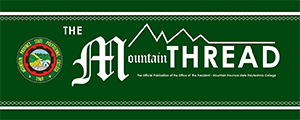DOCUMENTATION OF AGROFORESTRY SYSTEMS AND PRACTICES IN MOUNTAIN PROVINCE
Alexander T. Baldic
ABSTRACT
The study was conducted to generate broader information and appreciation of the agroforestry farming systems and practices in Mountain Province which is a basis for designing and developing appropriate agroforestry technology for future implementation. Specifically, the study aimed to document the agroforestry farming systems and practices adapted; enumerate the forestry and agricultural crops including available livestock components; identify other vegetation components of the agroforestry system. Weaknesses in terms of the implemented soil and water conservation measures were also determined.
Findings showed that mix cropping was the most adapted agroforestry farming system in Mountain Province which obtained the highest frequency and ranked among the 13 identified agroforestry systems in the province while taungya system, trees along farm boundaries + alley/strip cropping and aqua-silvipastoral systems obtained the lowest frequency and rank and was considered the least adapted agroforestry system.
Benguet pine was the most abundant forestry component of the identified agroforestry farms in Western Mountain Province as shown from the obtained highest frequency of 50 and a rank of 1. This was followed by alnus with a frequency of 30 and a rank of 2. In Eastern Mountain Province, gmelina obtained the highest frequency and rank as far as abundance of forest tree species within the agroforestry farms is concerned. Camellia, dael and molave trees were the least in number among the 19 identified forest tree components as shown from their common frequency of one (1) and a rank of 17.5
There were 36 identified fruit tree components of the agroforestry farms in Mountain Province. Banana obtained the highest frequency of 172 and rank number 1 followed by citrus with a frequency of 121 and rank number 2. Mango is ranked number 3 having a frequency of 102. Ranks 4, 5, 6, 7, and 8 with frequencies of 69, 63, 62, 58, and 44 respectively were guava, avocado, coconut, coffee and papaya. On the other hand, atis, apple, aswete, grapes and dragon fruit were the least in number as shown by their common frequency of 1 and rank number 36. Thirty-six (36) cash crop components were identified from the 100 agroforestry farms in Western Mountain Province. Sweet potato had a frequency of 41 and ranked number 1 followed by cassava that had a frequency of 35 and ranked number 2. Gabi is ranked 3 with a frequency of 28, cowpea is ranked 4 with a frequency of 22 and baguio beans is ranked 5 that obtained a frequency of 17.
Pineapple, chayote, sugarcane, onions, rice, and malunggay were ranked 6 to 10 as shown by their corresponding frequencies of 16, 15, 12, 6, 6, and 5 respectively. The following cash crops namely cabbage, kael, potato, black beans, carrots, peanut, corn, rosell, kal-lonay, hot pepper, tobacco, katuday, ginger, pamienta and garden pea garnered a common frequency of 1 and had the lowest rank of 24.5
In Western Mountain Province, goat, cow, carabao and horse were the ruminant components of other identified agroforestry systems. These animals do exist in silvipastoral, aqua-silvipastoral and agrisilvipastoral farms in Tadian, Mountain Province. Other agroforestry farms have developed their fishponds indicating the production of tilapia and jojo. From the findings, only 7 agroforestry farms out of the 100 farms visited and documented have constructed their fishponds within the agroforestry farms. Cow and carabao were the second most in number as indicated from the frequency of 4 and had a rank of 2.5. This is followed by goat and jojo production which had a common frequency of 2 and rank 4.5. The least frequency and rank it obtained was the horse because only one (1) farm had incorporated 3 horses.
In Eastern Mountain Province, tilapia production was the most common animal component as shown from its frequency of 5 and with a rank of 1. This is followed by jojo production with a frequency of 2 and had a corresponding rank of 2. It was observed further that goat, cow, carabao and torachok (eel-like) obtained the least frequency and rank. There were 28 vegetation components of the identified agroforestry farms in Mountain Province. These crops are shrubs, lianas, vines, grasses; perennials and annuals. Generally, sapsapon and poriket are the most abundant vegetation components of the agroforestry farms in which both of these obtained a common frequency of 180 and rank number 1.
This is followed by rono that garnered a frequency of 134 and had a rank of 2. Sunflower obtained a frequency of 129 and had a corresponding rank of 3. Meanwhile, galgalot and hagonoy obtained a frequency of 112 and a rank of 4.5. In contrast, golden bush which is an exotic bush obtained the lowest frequency and rank of 24 while betbetak and bangbang garnered a common frequency of 5 and a corresponding rank of 23. Generally, the implementation of soil and water conservation measures in most agroforestry farms particularly on slope areas was very weak. Agroforestry farms owners are only familiar with stone and brown-terracing and yet they claimed it is very expensive and laborious way of soil erosion mitigation measures. These farmers, however, claimed that composting is their usual practice of enriching soil fertility and elevating soil productivity.


















